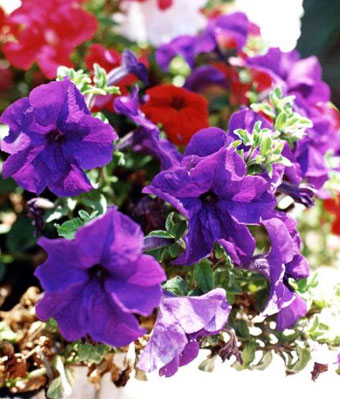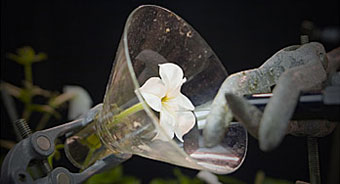Human Flower Project
Tuesday, March 28, 2006
Petunia Wizard
A scientist in Amsterdam is discovering the secrets of floral fragrance thanks to a humble bedding plant.

Petunia hybrida
Photo: Il Fioraio
Sophisticates may turn up their noses at petunias, the “teddy bear” of garden plants. But scientists of scent love them.
“Petunias naturally produce a large number of mutant forms, and it’s this genetic variability as well as their large and fragrant flowers which makes them ideal subjects for research into the genetic underpinnings of blossom and scent production.”
Through petunia research, Julian Verdonk of University of Amsterdam claims to have discovered the “masterswitch” of fragrance. He and his team managed to “trap” the volatile compounds of petunias (volatility gets the smell from the flower to your nose and brain) with a needle and glass funnel. The team identified twelve different “benzoid” molecules in petunias and began tracking their movement ‘round the clock.
 Extracting petunia scent
Extracting petunia scent
Photo: Radio Netherlands
Verdonk discerned a rhythm in petunia fragrance, “a 24 hour cycle with the maximum in the night.” Since petunias are pollinated by nocturnal moths, it makes sense they’d be most highly scented after sundown.
Also, Verdonk thinks he has found the specific gene that signals the plant to unleash fragrance (by suppressing that gene, he managed to snuff out the petunia’s odor).
“Using this knowledge we have now, we could really start to manipulate not only the scent of commercial flowers, but also taste and colour” of related fruits and vegetables, like tomatoes, which we learn, are petunia cousins.
The Europeans, historically, have been averse to transgenic plants, where botanical DNA gets dweedled with animal genes, pesticides or herbicides. Verdonk says that his petunia experiments should make improvements in plant fragrance possible without transgenics. “Instead classic breeding techniques could simply be speeded up, using ODO 1—the “masterswitch gene”—as a ‘marker’ for the requisite characteristics.”
These lab flowers may help restore spice to florists’ roses and tune some jazz into your store-bought tomato.
So, would y’all please stop treating the petunia as second-class citizen?
(For Dr. Verdonk’s full research findings, here’s the citation: Verdonk JC, Haring MA, Van Tunen AJ, Schuurink RC (2005) ODORANT1 Regulates Fragrance Biosynthesis in Petunia Flowers. Plant Cell. 17(5): 1612-24)




